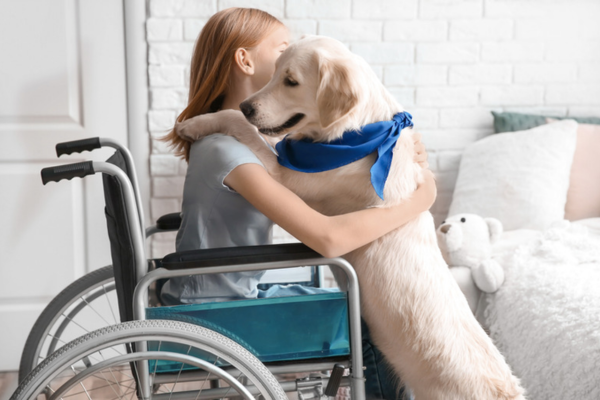Service dogs provide emotional support, assist with mobility, and can alert their handlers to help them avoid hazards.
But service dogs are especially integral in emergencies. They follow a service dog protocol to ensure their owner’s safety, and their roles in this capacity can save lives.
Understanding the Role of Service Dogs in Emergencies
A service dog training checklist is typically established to ensure dogs provide specific services in an emergency. Here are some examples.
- Assisting During Seizures: Service dogs can guard handlers to keep them safe if a seizure occurs. They may be able to break their fall to minimize injury. They can also help them get up after a seizure occurs.
- Preventing Diabetic Episodes: Service dogs are sensitive to changes in their handler’s body chemistry, including blood glucose levels. If they detect a change, they can alert their owner by jumping, barking, and whining. They can retrieve items like medication and press alert buttons to call for emergency services.
- Aiding with PTSD Episodes: A service dog can provide a physical barrier between their handler and approaching strangers when a PTSD episode occurs. They can also wake up their handler if they are having nightmares.
- Heart Problems: Cardiac service dogs can detect changes in heart rate and blood pressure. If a cardiac event occurs, they can prevent further injury and call for emergency services.
- Psychiatric Issues: Dogs can be a calming force during psychiatric episodes and can stop handlers from engaging in self-harming behavior.
Training for Emergency Situations
Service dogs undergo specific training to ensure they can handle emergencies. The training varies depending on the training facility and the handler’s needs. This YouTube video shows how a dog gets treats whenever she hits her handler’s life alert button.
The dog’s training will also vary depending on their role as a service animal. For example, they may be a medical alert dog, a medical response service dog, or a medical assistance dog.
Medical Alert Dogs
Medical alert dogs sense a medical crisis in its early stages. This skill is innate within the dog- it is not trained. The dog becomes so bonded with its owner that skill develops naturally.
Medical Response Dogs
Medical response dogs may not tune into medical emergencies in their early stages, but they will respond when they detect an emergency in progress. Once they determine an emergency is occurring, they will keep them safe, get them medication, dial 911, or hit a medical alert button.
Medical Assistance Dogs
Medical assistance dogs can detect an emergency in its early stages and will follow through with the appropriate response.
Service dogs are often asked to perform multiple drills to prepare for an emergency.
Preparedness Strategies for Handlers and Service Dogs
Title II of the ADA aims to ensure people with disabilities can access shelters and emergency services when necessary. For example, it mandates that shelters are wheelchair accessible. It also means that ‘no pet’ policies are modified to accommodate service dogs.
Handlers can ensure service dogs are included in an emergency plan by taking the following steps:
- Tell emergency responders that you have a service dog with you and need to be evacuated with your service dog
- Be prepared with food, water, ID tags, and any other supplies your dog requires
Shelter operators and first responders should understand that service dogs must stay with their owners and make accommodations for the service dog. Service dogs should be permitted to provide services, even if a staff member can provide similar services. They should not be subject to extra screening procedures.
If the handler is hospitalized, the dog should be permitted to stay with them. If that’s not possible, the handler can arrange to have the dog taken care of while they are in the hospital. The hospital may arrange boarding if the handler is not well enough to make arrangements.
Protocols During Emergencies
Handlers need to stay calm and follow service dog protocol when an emergency occurs. There are also protocols first responders should be aware of, such as:
- Transportation: Service dogs can accompany their handlers during evacuations and on ambulance rides.
- Identification: Handlers should be prepared to tell emergency response teams about their service dog, its importance, and why they have a legal right to stay with it during evacuations.
- Supplies: The handler should bring the supplies the dog needs during emergencies.
- Separation: If the service dog must be separated from the handler, it should stay close by. The dog and handler should be reunited as soon as possible.
- Questions: Emergency staff should not ask about the handler’s disability or require medical documentation for the dog.
Case Studies and Real-Life Examples
Several case studies and real-life examples have shown service dog benefits in emergencies. A 2019 qualitative analysis reviewed service dogs’ expectations and experiences. One handler mentioned her dog’s ability to get help when she faints or falls.
A 2019 case study reports that patients feel calmer when a service dog accompanies them on emergency room visits. The dogs improve their comfort levels, boost feelings, and reduce distress.
A 2023 NPR article reviewed how emergency dogs help with rescue missions. These FEMA-certified dogs undergo simulated drills to find toys in rubble. They played an integral role in recovering the bodies of people who died in a Hawaii wildfire.
Conclusion
Service dogs can be lifesavers in emergencies. Handlers can ensure they are prepared by familiarizing themselves with service dog protocol and creating a service dog training checklist. Review emergency plans with your dog to ensure readiness.
There are several resources for service dog training. The following institutions will help you find a trainer:
- K9 Training Institute
- APDT Resources
- The National Association of Obedience Instructors
- Karen Pryor Academy Training Listing
Justice Speaks is also always here for assistance. We help people who want to learn more about their handler rights, ensure workplace compliance, and teach school-aged children how to interact with service dogs.
Contact us to learn what to expect from a service dog experience.


